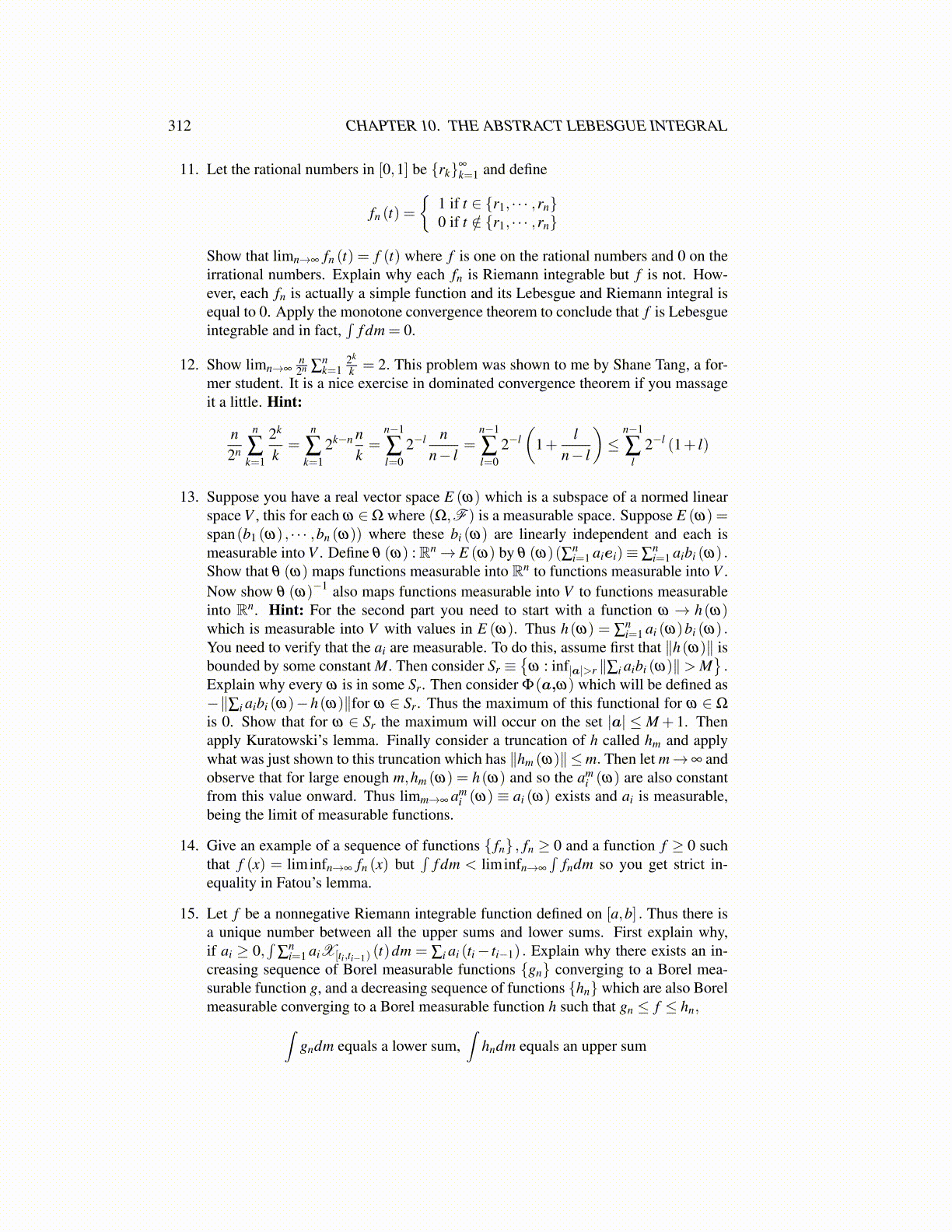
312 CHAPTER 10. THE ABSTRACT LEBESGUE INTEGRAL
11. Let the rational numbers in [0,1] be {rk}∞
k=1 and define
fn (t) ={
1 if t ∈ {r1, · · · ,rn}0 if t /∈ {r1, · · · ,rn}
Show that limn→∞ fn (t) = f (t) where f is one on the rational numbers and 0 on theirrational numbers. Explain why each fn is Riemann integrable but f is not. How-ever, each fn is actually a simple function and its Lebesgue and Riemann integral isequal to 0. Apply the monotone convergence theorem to conclude that f is Lebesgueintegrable and in fact,
∫f dm = 0.
12. Show limn→∞n2n ∑
nk=1
2k
k = 2. This problem was shown to me by Shane Tang, a for-mer student. It is a nice exercise in dominated convergence theorem if you massageit a little. Hint:
n2n
n
∑k=1
2k
k=
n
∑k=1
2k−n nk=
n−1
∑l=0
2−l nn− l
=n−1
∑l=0
2−l(
1+l
n− l
)≤
n−1
∑l
2−l (1+ l)
13. Suppose you have a real vector space E (ω) which is a subspace of a normed linearspace V , this for each ω ∈Ω where (Ω,F ) is a measurable space. Suppose E (ω) =span(b1 (ω) , · · · ,bn (ω)) where these bi (ω) are linearly independent and each ismeasurable into V . Define θ (ω) :Rn→ E (ω) by θ (ω)(∑n
i=1 aiei)≡∑ni=1 aibi (ω) .
Show that θ (ω) maps functions measurable into Rn to functions measurable into V .Now show θ (ω)−1 also maps functions measurable into V to functions measurableinto Rn. Hint: For the second part you need to start with a function ω → h(ω)which is measurable into V with values in E (ω). Thus h(ω) = ∑
ni=1 ai (ω)bi (ω) .
You need to verify that the ai are measurable. To do this, assume first that ∥h(ω)∥ isbounded by some constant M. Then consider Sr ≡
{ω : inf|a|>r ∥∑i aibi (ω)∥> M
}.
Explain why every ω is in some Sr. Then consider Φ(a,ω) which will be defined as−∥∑i aibi (ω)−h(ω)∥for ω ∈ Sr. Thus the maximum of this functional for ω ∈ Ω
is 0. Show that for ω ∈ Sr the maximum will occur on the set |a| ≤ M + 1. Thenapply Kuratowski’s lemma. Finally consider a truncation of h called hm and applywhat was just shown to this truncation which has ∥hm (ω)∥ ≤m. Then let m→∞ andobserve that for large enough m,hm (ω) = h(ω) and so the am
i (ω) are also constantfrom this value onward. Thus limm→∞ am
i (ω) ≡ ai (ω) exists and ai is measurable,being the limit of measurable functions.
14. Give an example of a sequence of functions { fn} , fn ≥ 0 and a function f ≥ 0 suchthat f (x) = liminfn→∞ fn (x) but
∫f dm < liminfn→∞
∫fndm so you get strict in-
equality in Fatou’s lemma.
15. Let f be a nonnegative Riemann integrable function defined on [a,b] . Thus there isa unique number between all the upper sums and lower sums. First explain why,if ai ≥ 0,
∫∑
ni=1 aiX[ti,ti−1) (t)dm = ∑i ai (ti− ti−1) . Explain why there exists an in-
creasing sequence of Borel measurable functions {gn} converging to a Borel mea-surable function g, and a decreasing sequence of functions {hn} which are also Borelmeasurable converging to a Borel measurable function h such that gn ≤ f ≤ hn,∫
gndm equals a lower sum,∫
hndm equals an upper sum